Scottish Health Survey – telephone survey – August/September 2020: main report
Presents results for the Scottish Health Survey – telephone survey- August to September 2020, providing information on the health and factors relating to health of people living in Scotland.
Chapter 2: Mental Wellbeing
This summary covers data collected between the 5th August 2020 and the 23rd September 2020.
Mental wellbeing (WEMWBS mean score*) varied by age with a significantly higher score among those aged 65-74.
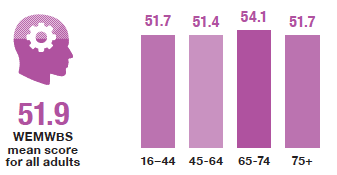
Mental wellbeing (WEMWBS mean score*) increased with frequency of contact with friends, relatives or neighbours.
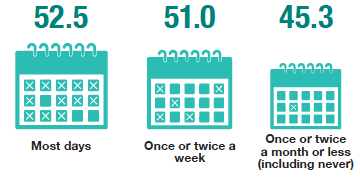
Mental wellbeing (WEMWBS mean score*) also increased with the number of people adults felt they could turn to in a crisis.
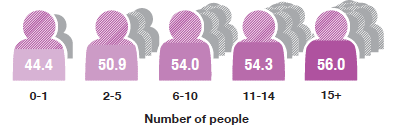
Adults who were advised to shield reported lower mental wellbeing (WEMWBS mean score*) than those who were not.

48.5 Adults who had been advised to shield
52.5 Adults who had not been advised to shield
The prevalence of adults with a GHQ-12 score of four or more** was lower in the older age groups.
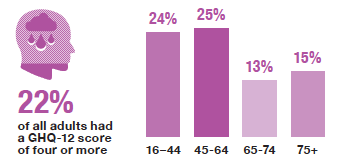
Adults who were advised to shield were more likely to report a GHQ-12 score of four or more** than those who were not.

Adults aged 64 and under were more likely to report two or more symptoms of anxiety.
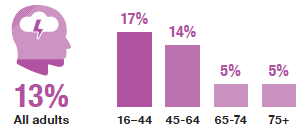
Around one in ten adults reported two or more symptoms of depression.
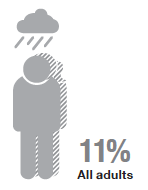
2 Mental Wellbeing
Victoria Wilson
2.1 Introduction
Mental health is defined by the World Health Organization as a state of well-being in which every individual realises their own potential, can cope with the stresses of life, can work productively, and is able to make a contribution to their community[1]. Positive mental health encourages better quality of life overall, healthier lifestyles, better physical health, improved recovery from illness, better social relationships, and higher educational attainment[2].
The impact of the COVID-19 pandemic is likely to be felt widely at both societal and individual levels, impacting on mental health. In response to this, the Mental Health – Scotland’s Transition and Recovery Plan[3] sets out the mental health needs resulting from the pandemic and lockdown and how the Scottish Government will address these.
The plan’s commitments focus on areas or groups of people where COVID-19 is likely to have particularly impacted on mental health. Each area of focus includes responses that span multiple types of need including:
1. Promoting and supporting conditions for good mental health and wellbeing at a population level
2. Providing accessible signposting to help, advice and support
3. Providing rapid and easily accessible responses for those in distress, and
4. Ensuring safe, effective treatment and care for those living with a mental illness[3].
The plan acknowledges a range of pandemic-related pressures that may have impacted on mental wellbeing. That includes inequalities, employment, impacts on particular groups such as children, young people, families, older people, and those with long-term conditions or disabilities[3].
Additionally, the plan lays out government action to provide the right help and support for mental illness. In particular, it illustrates the government’s vision for the renewal of mental health services, including CAMHS and psychological therapies[3].
At the time of data collection for this survey, easing of restrictions on time outside of the home, social interaction and businesses that could open had been introduced, although some restrictions on the number of people that could meet were reintroduced during the fieldwork period[4].
This chapter presents findings related to adult mental health and wellbeing in Scotland in August and September 2020. Information on methods and definitions can be found in the Volume 2: Technical Report.
2.2 Mental Wellbeing
The fieldwork period referenced in the following analysis covers from the 5th August 2020 to 23rd September 2020.
In interpreting these results, note that, in this survey these questions were asked as part of the main interview. Questions on mental health are potentially sensitive in nature, and in the usual format of a Scottish Health Survey interview in the home they are included in a self-completion form which the participants complete themselves rather than the interviewer asking the questions. Self-completion formats may illicit a more accurate response from some participants who feel more comfortable answering sensitive questions privately. For this reason and as indicators of poor mental health tend to be higher in deprived areas where response to this survey was lower than usual, the following indicators may underestimate poor mental health and overestimate mental wellbeing. See section 1.9.3 of the technical report for further details.
2.2.1 Adult WEMWBS mean score, August/September 2020, by age and sex
Wellbeing is measured using the Warwick-Edinburgh Mental Wellbeing Scale (WEMWBS). This uses 14 positively worded statements to assess overall mental wellbeing, with 14 the lowest score possible and 70 the highest. For more information, see section 1.9.3 of the Volume 2 Technical report.
The average WEMWBS score for all adults during the fieldwork period was 51.9. Mental wellbeing was significantly higher among those aged 65-74, with an average score of 54.1 recorded compared with scores in the range 51.4 – 51.7 recorded among those aged 16-64 and 75 and over.
Similar patterns by age were evident for both men and women with no significant variations by sex.
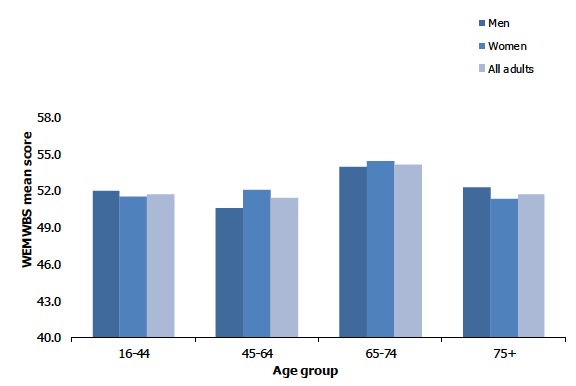
Figure 2A, Table 2.1
2.2.2 Adult WEMWBS mean score, August/September 2020, by contact with other people and sex
Mental wellbeing increased with frequency of contact with other people[5] reported during the fieldwork period, with a linear increase in the mean WEMWBS score from 45.3 among those who reported being in contact with friends, relatives or neighbours ‘once or twice a month or less often (including never)’ to 52.5 among those in such contact on ‘most days’. Table 2.2
2.2.3 Adult WEMWBS mean score, August/September 2020, by number of people can turn to in a crisis and sex
Mental wellbeing increased with the number of people adults felt they could turn to in a crisis. The mean WEMWBS score increased from 44.4 among those who reported having no one or just one other person to turn to for support in a crisis to 50.9 among those with between two and five people to turn to and 54.0 – 56.0 among those who reported having six or more people to turn to.
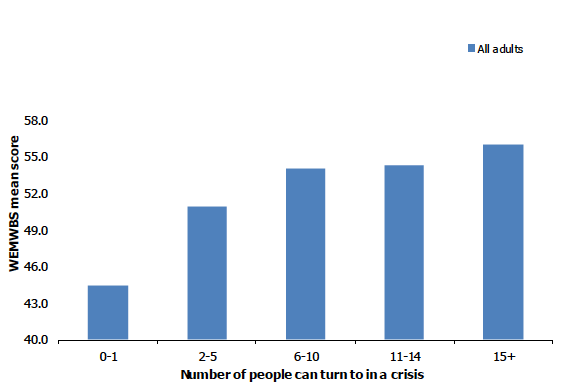
No significant variations were evident by sex, with similar patterns for both men and women.
Figure 2B, Table 2.3
2.2.4 Adult WEMWBS mean score, August/September 2020, by whether received shielding letter/text and sex
Those who had been advised to shield (either by letter or text) were likely to have lower mental wellbeing than those who had not (WEMWBS mean scores of 48.5 and 52.3 respectively). This pattern in mental wellbeing by shielding status was evident for both men and women with no significant variations by sex. Table 2.4
2.2.5 GHQ-12 score, August/September 2020, by age and sex
General Health Questionnaire-12 (GHQ-12)[6] is a widely used standard measure of mental distress and mental ill-health consisting of 12 questions on concentration abilities, sleeping patterns, self-esteem, stress, despair, depression, and confidence in the previous few weeks. These scores are combined to create an overall score of between zero and twelve. A score of four or more (referred to as a high GHQ-12 score) has been used here to indicate the presence of a possible psychiatric disorder. In interpreting these results, in addition to the point noted at the start of section 2.2, it is possible that some people may have answered ‘less so than usual’ or ‘much less than usual’ to the GHQ-12 question ‘Have you recently been able to enjoy your normal day to day activities’ because they were not able to undertake their usual activities because of the pandemic restrictions rather than because they were enjoying their day to day activities less than usual. This may have impacted upon their overall GHQ-12 score.
For more information, see section 1.9.3 of the Volume 2 Technical report.
Just over a fifth (22%) of all adults recorded a GHQ-12 score of four or more (indicative of a possible psychiatric disorder). The proportion of adults with a GHQ-12 score of four or more decreased with age from 24% - 25% among those aged 16-64 to 13% - 15% among those aged 65 and over.
The reverse was evident for the proportions that recorded a score of zero which rose from 37% - 39% among those aged 16-64 to 48% among those aged 65 and over.
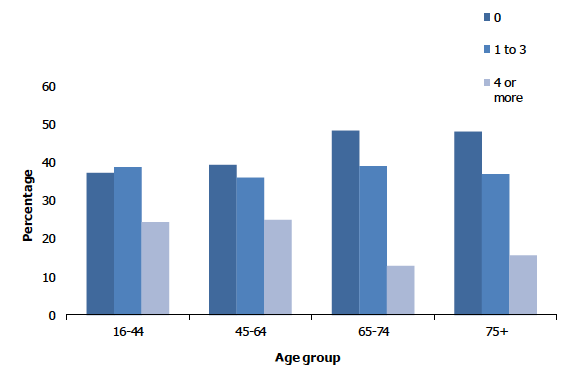
No statistically significant variations by sex were observed, including for the patterns of GHQ-12 score of four or more by age recorded for both men and women.
Figure 2C, Table 2.5
2.2.6 GHQ-12 score, August/September 2020, by whether received shielding letter/text and sex
Among all adults, the proportions with a GHQ-12 score of four or more (indicative of a possible psychiatric disorder) varied by whether or not adults had been advised to shield. Among those who were advised to shield (by letter or text) around a third (32%) had a score of four or more, compared with around a fifth (21%) of those who were not advised to shield.
Similar patterns were recorded for both men and women, with no significant variations by sex. Table 2.6
2.2.7 CIS-R anxiety and depression scores, August/September 2020, by age and sex
Details on symptoms of depression and anxiety are collected via a standardised instrument, the Revised Clinical Interview Schedule (CIS-R). The CIS-R is a well-established tool for measuring the prevalence of mental disorders[7]. The complete CIS-R comprises 14 sections, each covering a type of mental health symptom and asks about presence of symptoms in the week preceding the interview. Prevalence of two of these mental illnesses - depression and anxiety were included in the telephone survey. For more information, see section 1.9.3 of the Volume 2 Technical report.
Just over one in ten (11%) adults reported two or more symptoms of depression during the data collection period. The proportion increased from 11% among those aged 16-44 to 13% among those aged 45-64 before decreasing to 7% among those aged 75 and over, although this difference was not statistically significant. There was no significant difference in the proportion reporting two or more symptoms of depression between men and women (12% and 10% respectively) and the pattern by age for men and women was also not significantly different.
Among all adults, 13% recorded two or more symptoms of anxiety. Significant variations by age were evident, with two or more symptoms of anxiety recorded for 14% - 17% of adults aged 16-64 compared with 5% of adults aged 65 and over. No significant variations by sex were evident, with similar patterns recorded for men and women when analysed by age.
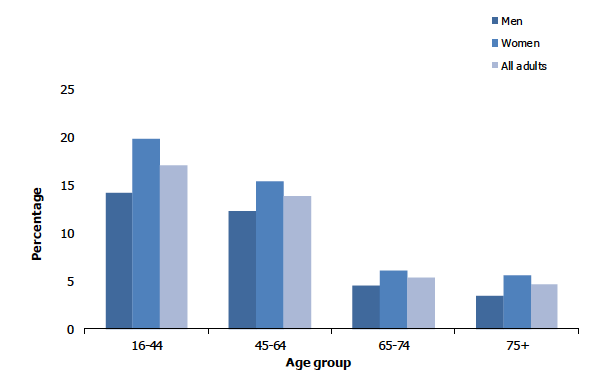
Figure 2D, Table 2.7
2.2.8 CIS-R anxiety and depression scores, August/September 2020, by whether received shielding letter/text and sex
A higher proportion of adults who received a letter or text advising them to shield recorded two or more symptoms of depression than those who were not advised to shield (17% and 11% respectively), although this difference was not statistically significant. While the gap by shielding status was larger for men (19% and 11% respectively) than for women (15% and 10% respectively), these differences by sex were also not statistically significant.
The proportions of adults with two or more symptoms of anxiety did not differ between those who were advised to shield and those who were not (17% and 13% respectively). Similar patterns were recorded for both men and women, with no significant variations by sex. Table 2.8
Table List
Table 2.1 Adult WEMWBS mean score, August/September 2020, by age and sex
Table 2.2 Adult WEMWBS mean score, August/September 2020, by contact with other people and sex
Table 2.3 Adult WEMWBS mean score, August/September 2020, by number of people can turn to in a crisis and sex
Table 2.4 Adult WEMWBS mean score, August/September 2020, by whether received shielding letter/text and sex
Table 2.5 GHQ-12 score, August/September 2020, by age and sex
Table 2.6 GHQ-12 score, August/September 2020, by whether received shielding letter/text and sex
Table 2.7 CIS-R anxiety and depression scores, August/September 2020, by age and sex
Table 2.8 CIS-R anxiety and depression scores, August/September 2020, by whether received shielding letter/text and sex
The tables can be found in the main report page under supporting documents.
References and notes
1. World Health Organization (2018). Mental Health: strengthening our response. [Online]
2. World Health Organization (2009). Mental health, resilience and inequalities. [online].
3. Mental Health – Scotland’s Transition and Recovery. Edinburgh: Scottish Government (2020).
4. Coronavirus (COVID-19): Scotland’s route map. Edinburgh: Scottish Government (2020).
5. This includes contact in person, by phone, letter, email or through the internet.
6. Goldberg, D and Williams, PA (1988). A User's Guide to the General Health Questionnaire. Windsor: NFER-Nelson.
7. Lewis, G. & Pelosi, A. J. (1990). Manual of the Revised Clinical Interview Schedule CIS–R. London: Institute of Psychiatry; Lewis G, Pelosi AJ, Araya R, Dunn G. (1992) Measuring psychiatric disorder in the community; a standardised assessment for use by lay interviewers. Psychological Medicine; 22, 465-486.
Contact
There is a problem
Thanks for your feedback